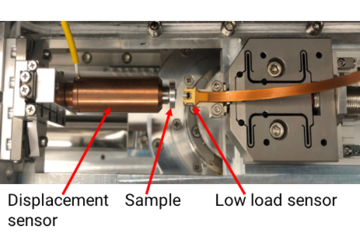All genres
201.
Journal Article
Substantially enhanced plasticity of bulk metallic glasses by densifying local atomic packing. Nature Communications 12, 6582 (2021)
202.
Journal Article
Segregation-assisted spinodal and transient spinodal phase separation at grain boundaries. npj Computational Materials 6, 191 (2020)
203.
Journal Article
Dynamic Effects in Voltage Pulsed Atom Probe. Microscopy and Microanalysis 26 (6), pp. 1133 - 1146 (2020)
204.
Journal Article
Enabling near-atomic–scale analysis of frozen water. Science Advances 6 (49), eabd6324 (2020)
205.
Journal Article
Controlling the Oxidation of Magnetic and Electrically Conductive Solid-Solution Iron-Rhodium Nanoparticles Synthesized by Laser Ablation in Liquids. Nanomaterials 10 (12), 2362 (2020)
206.
Journal Article
Analysis of nanoscale fluid inclusions in geomaterials by atom probe tomography: Experiments and numerical simulations. Ultramicroscopy 218, 113092 (2020)
207.
Journal Article
Extensive nanoprecipitate morphology transformation in a nanostructured ferritic alloy due to extreme thermomechanical processing. Acta Materialia 200, pp. 922 - 931 (2020)
208.
Journal Article
Nanocrystalline Sm-based 1:12 magnets. Acta Materialia 200, pp. 652 - 658 (2020)
209.
Journal Article
Reversion and re-aging of a peak aged Al–Zn–Mg–Cu alloy. Scripta Materialia 188, pp. 269 - 273 (2020)
210.
Journal Article
Different Photostability of BiVO4 in Near-pH-Neutral Electrolytes. ACS Applied Energy Materials 3 (10), pp. 9523 - 9527 (2020)
211.
Journal Article
Corrigendum to ‘On the Re segregation at the low angle grain boundary in a single crystal Ni-base superalloy’ Scripta Materialia Volume 185, August 2020, Pages 88-93 (Scripta Materialia (2020) 185 (88–93), (S1359646220302475), (10.1016/j.scriptamat.2020.03.063)). Scripta Materialia 187, p. 309 (2020)
212.
Journal Article
On the chemistry of grain boundaries in CuInS2 films. Nano Energy 76, 105072 (2020)
213.
Journal Article
An atom probe tomography and inventory calculation examination of second phase precipitates in neutron irradiated single crystal tungsten. Nuclear Fusion 60 (12), 126013 (2020)
214.
Journal Article
In-situ synthesis via laser metal deposition of a lean Cu–3.4Cr–0.6Nb (at%) conductive alloy hardened by Cr nano-scale precipitates and by Laves phase micro-particles. Acta Materialia 197, pp. 330 - 340 (2020)
215.
Journal Article
Current Challenges and Opportunities in Microstructure-Related Properties of Advanced High-Strength Steels. Metallurgical and Materials Transactions A 51, pp. 5517 - 5586 (2020)
216.
Journal Article
The effect of solute segregation to deformation twin boundaries on the electrical resistivity of a single-phase superalloy. Scripta Materialia 186, pp. 208 - 212 (2020)
217.
Journal Article
Plasticity assisted redistribution of solutes leading to topological inversion during creep of superalloys. Scripta Materialia 186, pp. 287 - 292 (2020)
218.
Journal Article
Chemical segregation and precipitation at anti-phase boundaries in thermoelectric Heusler-Fe2VAl. Scripta Materialia 186, pp. 370 - 374 (2020)
219.
Journal Article
Intermixing of Fe and Cu on the atomic scale by high-pressure torsion as revealed by DC- and AC-SQUID susceptometry and atom probe tomography. Acta Materialia 196, pp. 210 - 219 (2020)
220.
Journal Article
Application of SIMS and APT to Understand Scale Dependent U-Pb Isotope Behavior in Zircon. Microscopy and Microanalysis 26 (S2), pp. 2994 - 2995 (2020)











